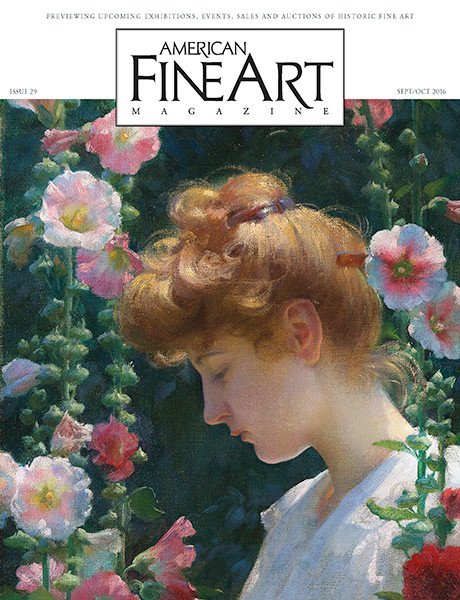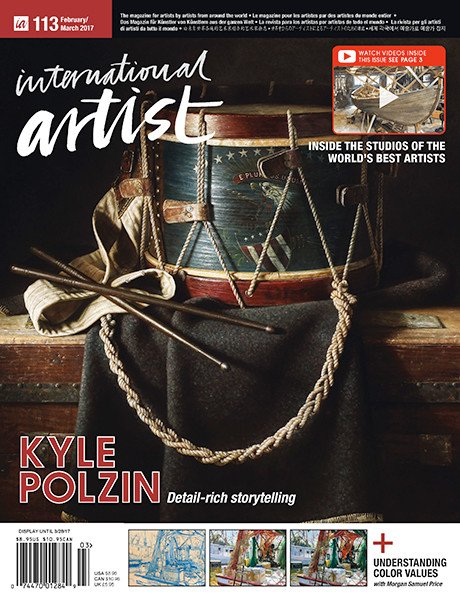On view at Crystal Bridges Museum of American Art through January 27, 2025, Knowing the West: Visual Legacies of the American West was curated to explore and expand how people see the American West. It aims to tell a more inclusive story by showcasing the diverse groups who shaped the art and life of the West.
 Joseph No Two Horns or He Nupa Wanica (Hunkpapa Lakota, Teton Sioux, 1852-1942), Winter Count, ca. 1922. Ink, watercolors and crayon on muslin, 93 x 36”. Jo Anderson, Omaha, Nebraska. Photo: Jeffrey Wells.
Joseph No Two Horns or He Nupa Wanica (Hunkpapa Lakota, Teton Sioux, 1852-1942), Winter Count, ca. 1922. Ink, watercolors and crayon on muslin, 93 x 36”. Jo Anderson, Omaha, Nebraska. Photo: Jeffrey Wells.
Co-curated by Mindy Besaw, Crystal Bridges’ curator of American art and director of research, fellowships and university partnerships, and Jami Powell (Osage), associate director for curatorial affairs and curator of Indigenous art at New Hampshire’s Hood Museum of Art, the exhibition presents more than 120 historic works by Native and non-Native American artists, including textiles, baskets, paintings, pottery, sculpture, beadwork, saddles and prints, spanning the early 19th century to today.
 Nellie Two Bear Gates (Iháƞktȟuƞwaƞna Dakhóta, Standing Rock Reservation, 1854-1935), Suitcase, 1880-1910. Bead, hide, oilcloth and thread, 12½ x 1711/16 x 10¼”. Minneapolis Institute of Arts, Minneapolis, MN. The Robert J. Ulrich Works of Art Purchase Fund. Photo: Minneapolis Institute of Art.
Nellie Two Bear Gates (Iháƞktȟuƞwaƞna Dakhóta, Standing Rock Reservation, 1854-1935), Suitcase, 1880-1910. Bead, hide, oilcloth and thread, 12½ x 1711/16 x 10¼”. Minneapolis Institute of Arts, Minneapolis, MN. The Robert J. Ulrich Works of Art Purchase Fund. Photo: Minneapolis Institute of Art.
Powell says, “Throughout the development and planning for this exhibition, we have prioritized the display of works by Native American artists—and particularly works by women—not only to celebrate the depth, breadth, diversity, and dynamic nature of Indigenous art of the West, but to demonstrate the significant impacts of Indigenous creative expression on the formation of the United States more broadly. In focusing on narratives and ways of knowing that may be unfamiliar to some audiences, the exhibition aims to expand rather than replace existing impressions of the West.”
 Maria Martinez (San Ildefonso Pueblo, 1887-1980) and Julian Martinez (San Ildefonso Pueblo, 1879-1943), Storage Jar, 1926. Clay and paint, 16 x 18¾”. Courtesy of the School for Advanced Research. Indian Arts Fund purchase for the permanent collection, 1928. Photography by Addison Doty.
Maria Martinez (San Ildefonso Pueblo, 1887-1980) and Julian Martinez (San Ildefonso Pueblo, 1879-1943), Storage Jar, 1926. Clay and paint, 16 x 18¾”. Courtesy of the School for Advanced Research. Indian Arts Fund purchase for the permanent collection, 1928. Photography by Addison Doty.
Among the featured Native American artists are Nellie Two Bear Gates (Iháƞktȟuƞwaƞna Dakhóta, Standing Rock Reservation), Maria and Julian Martinez (San Ildefonso Pueblo), Joseph No Two Horns or He Nupa Wanica (Hunkpapa Lakota, Teton Sioux), Elizabeth Conrad Hickox and Louise Hickox (Karuk/Wiyot), Louisa Keyser or Dat-so-la-Lee (Washoe), Maria Katitse or Saivutesta (Zuni Pueblo), Lucy Lewis (Acoma Pueblo) Miranda (Diné (Navajo)) and others, including historic works by artists once known. Depicting the years 1785 through 1922, No Two Horns’ large muslin Winter Count provides a framework for the exhibition whose majority of objects are from the mid-19th century through about 1930. No Two Horns was a Hunkpapa Sioux warrior who fought in approximately 40 battles, including the Battle of the Little Bighorn. He kept the Winter Count, pictograph records of history for his people. He also made weapons, and illustrations of Sioux warrior life on paper, cloth, wood and hide.
 Miranda (Diné (Navajo)), Serape, ca. 1892. Commercial wool yarn and commercial cotton string, 883/5 x 669/10”. The Crane Collection at the Denver Museum of Nature & Science.
Miranda (Diné (Navajo)), Serape, ca. 1892. Commercial wool yarn and commercial cotton string, 883/5 x 669/10”. The Crane Collection at the Denver Museum of Nature & Science.
Another significant work is a suitcase by Two Bear Gates dated 1880-1910. According to the Minneapolis Institute of Art, Gates made the beaded suitcase as a wedding gift for her relative Ida Claymore. The suitcase illustrates the union of two families with one side depicting the bride and her family among the food and gifts offered to celebrate the marriage. At the top, 11 horses frame two figures (likely Ida’s parents), who stand on either side of suspended kettles symbolizing the large amounts of food given at this time. At bottom, the bride stands next to her tipi, fully adorned, with more gifts. The other side, featuring cowboys and rope cattle, likely relates to the groom’s family, who were ranchers.
A basket from around 1925 by Elizabeth Conrad Hickox and her daughter Louise Hickox is also of note. Dartmouth’s Hood Museum explains, “To create this lidded basket, the Hickoxes used a twining technique to incorporate staghorn lichen–dyed porcupine quills with tightly woven maidenhair fern. The deep purple-black of the fern, combined with the golden yellow porcupine quills, provides the perfect contrast to highlight the bear paw design cascading around the form.”
 Artist once known (Blackfeet), Doll, including horse, dress, and miniature cradleboard, 1870-1890. Leather, beads, wool, sticks and horsehair, 6¼ x 6”. Courtesy of the Kansas City Museum and Union Station Kansas City, Kansas City, Missouri.
Artist once known (Blackfeet), Doll, including horse, dress, and miniature cradleboard, 1870-1890. Leather, beads, wool, sticks and horsehair, 6¼ x 6”. Courtesy of the Kansas City Museum and Union Station Kansas City, Kansas City, Missouri.
Maria Martinez formed clay into fired and burnished vessels, and her husband, Julian, painted designs on some of her finished pots. As seen in their polychrome Storage Jar from 1926, the combination of her expertly formed vessels and his elegant designs brought the couple great acclaim, inspiring other potters and influencing the revival of pottery traditions in the pueblos.
“This exhibition recontextualizes historic artwork, encourages deeper exploration of a familiar topic, and celebrates the rich cultures that reflect the complexity of the American West,” says co-curator Besaw. “Art of the West is so often presented in simplified and binary terms—such as ‘cowboys and Indians’—which does little to embrace the multiplicity of artists and communities in the West. But Knowing the West goes beyond this typical scenario, showcasing works by…many artists who have been historically overlooked and underrepresented.”
 Elizabeth Conrad Hickox (Karuk/Wiyot, 1875-1947) and Louise Hickox (Karuk [Karok], 1896-1967), Basket, ca. 1925. Wild grape root, myrtle sticks, hazel, maidenhair fern, yellow-dyed porcupine quills, staghorn lichen, 8 x 81/16 x 81/16”. Hood Museum of Art, Dartmouth, Hanover, NH. Gift of Mrs. James Foster Scott, in memory of her late husband, Victor J. Evans.
Elizabeth Conrad Hickox (Karuk/Wiyot, 1875-1947) and Louise Hickox (Karuk [Karok], 1896-1967), Basket, ca. 1925. Wild grape root, myrtle sticks, hazel, maidenhair fern, yellow-dyed porcupine quills, staghorn lichen, 8 x 81/16 x 81/16”. Hood Museum of Art, Dartmouth, Hanover, NH. Gift of Mrs. James Foster Scott, in memory of her late husband, Victor J. Evans.
After the exhibition’s stay at Crystal Bridges, it will travel to the Cummer Museum of Art & Gardens in Jacksonville, Florida, and the North Carolina Museum of Art in Raleigh.
Through January 27, 2025
Knowing the West: Visual Legacies of the American West
Crystal Bridges Museum of American Art 600 Museum Way, Bentonville, AR 72712 (479) 418-5700, www.crystalbridges.org
Powered by Froala Editor














































